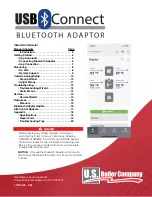
17
Chapter 4: Setting up and Connecting the USB Network Adapter
Setting Up the Adapter
Wireless-G USB Network Adapter
4. The
Wireless
Security
screen will appear. This step will configure wireless security.
If your wireless network doesn’t use wireless security, select
Disabled
and then click the
Next
button to
continue. Proceed to Step 5.
Select
WEP
,
WPA-Personal
,
PSK2, WPA Enterprise
,
Radius, or LEAP
for the Encryption Method. WEP
stands for Wired Equivalent Privacy, WPA stands for Wi-Fi Protected Access, which is a security standard
stronger than WEP encryption, PSK2 stands for Pre-Shared Key 2, which is a security standard stronger than
WPA-Personal, RADIUS stands for Remote Authentication Dial-In User Service, and LEAP stands for
Lightweight Extensible Authentication Protocol. If you don’t want to use encryption, select
Disabled
. To use
the advanced features, click the
Advanced
button.
Then, click the
Next
button to continue or the
Back
button to return to the previous screen.
WEP
WEP
- To use WEP encryption, select 64-bits or 128-bit characters from the drop-down menu, and enter a
passphrase or key.
WEP Key
- The WEP key you enter must match the WEP key of your wireless network. If you are using 64-bit
WEP encryption, then the key must consist of exactly 10 hexadecimal characters. If you are using 128-bit
WEP encryption, then the key must consist of exactly 26 hexadecimal characters. Valid hexadecimal
characters are “0” to “9” and “A” to “F”.
Passphrase
- Instead of manually entering a WEP key, you can enter a passphrase in the Passphrase field, so
a WEP key is automatically generated. This case-sensitive passphrase must match the passphrase of your
other wireless network devices and is compatible with Linksys wireless products only. (If you have any non-
Linksys wireless products, enter the WEP key manually on those products.)
TX Key
- The default transmit key number is 1. If your network’s access point or wireless router uses transmit
key number 2, 3, or 4, select the appropriate number from the
TX Key
drop-down box.
Authentication
-The default is set to
Auto
, where it auto-detects for
Shared Key
or
Open
system. Shared
Key is when both the sender and the recipient share a WEP key for authentication. Open key is when the
sender and the recipient do not share a WEP key for authentication. All points on your network must use the
same authentication type.
Figure 4-20: Wireless Security
encryption:
encoding data transmitted in a network.
Figure 4-21: Wireless Security - WEP
wep
(wired equivalent privacy): a method of encrypting network
data transmitted on a wireless network for greater security.















































